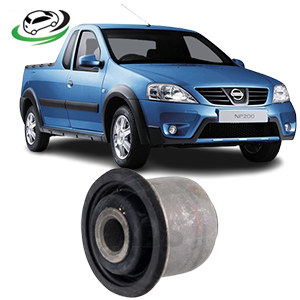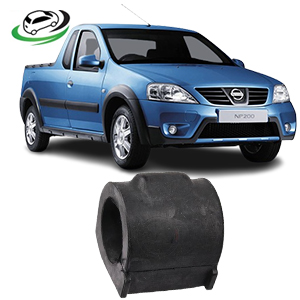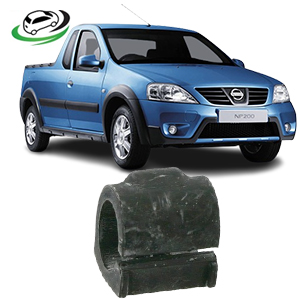Get Nissan Pick Up NP200 Front Bush-Stabilizer 54613-00Q0B
The front stabilizer bushing, also known as a sway bar bushing, is a crucial component in a vehicle’s suspension system. It plays a vital role in enhancing vehicle stability, improving handling, and ensuring a smooth ride. By connecting the sway bar (or stabilizer bar) to the vehicle’s chassis, the bushing allows for controlled movement of the suspension system while absorbing vibrations and impacts. This detailed exploration will cover the structure, function, types, importance, maintenance, and signs of failure of front stabilizer bushings.
Structure of the Front Stabilizer Bushing
The front stabilizer bushing typically consists of several key components:
- Bushing Material: Most commonly made from rubber or polyurethane, the bushing serves as a cushion between the sway bar and the chassis. Rubber is favored for its excellent vibration-damping qualities, while polyurethane is preferred for its durability and stiffness.
- Inner Sleeve: This metal tube fits inside the bushing and allows the sway bar to pass through it. The inner sleeve helps to maintain proper alignment and provides a pivot point for the sway bar’s movement.
- Outer Shell: The outer part of the bushing, usually made of rubber or another composite material, surrounds the inner sleeve. This outer shell secures the bushing to the vehicle’s chassis and absorbs road vibrations.
- Bonded Design: In many cases, the rubber or polyurethane is bonded to both the inner sleeve and outer shell, preventing slippage and ensuring a tight fit. This design helps maintain alignment and reduces the likelihood of wear over time.
Function of the Front Stabilizer Bushing
The primary function of the front stabilizer bushing is to connect the sway bar to the vehicle’s chassis while allowing for controlled movement. Here are its main functions:
- Stabilizing the Vehicle: The stabilizer bushing helps the sway bar counteract body roll during cornering. When a vehicle turns, the weight shifts, and the sway bar works to keep the body level, enhancing stability.
- Absorbing Vibrations: The bushing acts as a cushion that absorbs road shocks and vibrations, preventing these forces from being transmitted directly to the vehicle’s chassis and occupants. This leads to a more comfortable ride.
- Maintaining Suspension Geometry: By securing the sway bar in place, the stabilizer bushing helps maintain the correct geometry of the suspension system. This is crucial for proper wheel alignment and handling characteristics.
- Noise Reduction: The bushing minimizes noise generated by the sway bar’s movement. Without it, metal-on-metal contact could lead to clunking or rattling sounds, compromising the driving experience.
- Facilitating Controlled Movement: The bushing allows the sway bar to pivot smoothly as the suspension moves, enabling the suspension to function as intended and improving overall ride quality.
Types of Front Stabilizer Bushings
Different types of front stabilizer bushings are available, each offering unique characteristics and benefits:
- Rubber Bushings: The most common type used in standard vehicles. Rubber bushings provide excellent vibration damping and noise reduction, making them suitable for everyday driving. However, rubber can deteriorate over time due to exposure to heat, oil, and environmental factors.
- Polyurethane Bushings: These bushings are stiffer and more durable than rubber alternatives. They offer improved handling and responsiveness, making them popular in performance applications. While they provide better control, they may transmit more noise and vibration to the cabin.
- Hydraulic Bushings: Advanced designs that incorporate fluid-filled chambers to enhance vibration absorption. These are typically used in high-performance or luxury vehicles, providing a smoother ride and reducing noise effectively.
- Solid Bushings: These eliminate much of the flex associated with rubber or polyurethane, providing extremely precise handling. They are often used in racing applications where control is prioritized over comfort.
- Adjustable Bushings: Some aftermarket options allow for fine-tuning of the suspension geometry to suit specific driving conditions or preferences. This flexibility can be beneficial for enthusiasts looking to optimize their vehicle’s handling.
Importance of Front Stabilizer Bushings
The front stabilizer bushing assembly is essential for several reasons:
- Enhanced Ride Comfort: By absorbing shocks and vibrations, the bushing contributes to a more comfortable driving experience. Passengers are less affected by road imperfections, making for a smoother ride.
- Improved Handling and Stability: Properly functioning bushings help maintain wheel alignment and stability, enhancing handling characteristics during cornering and sudden maneuvers. This is critical for safe driving, especially in adverse conditions.
- Increased Suspension Longevity: The bushing helps reduce wear on other suspension components by absorbing impacts and controlling movement, extending the lifespan of the entire suspension system.
- Enhanced Safety: A well-functioning stabilizer bushing ensures that the sway bar operates correctly, contributing to vehicle stability and reducing the risk of accidents. Compromised bushings can lead to unpredictable handling.
- Noise Reduction: By cushioning the connection between the sway bar and chassis, the bushing minimizes noise, creating a quieter cabin environment and enhancing the overall driving experience.
Maintenance of Front Stabilizer Bushings
Regular maintenance is vital to ensure the longevity and performance of the front stabilizer bushing assembly:
- Routine Inspections: Regularly inspect the bushings for signs of wear, such as cracks, tears, or excessive movement. Rubber bushings are particularly susceptible to degradation over time.
- Listen for Noise: If you hear clunking or rattling noises from the front suspension, it may indicate worn bushings. These sounds often arise when the sway bar moves excessively due to degraded bushings.
- Replace Worn Bushings: Front stabilizer bushings should be replaced if they show signs of wear or damage. Depending on driving conditions, replacement may be necessary every 50,000 to 100,000 miles.
- Lubrication: Some bushings, particularly polyurethane types, may require periodic lubrication to reduce friction and prevent squeaking. Always use the manufacturer-recommended lubricant.
- Check Suspension Alignment: Ensuring proper alignment of the suspension system is crucial. Misaligned bushings can lead to uneven tire wear and handling issues.
Symptoms of Failing Front Stabilizer Bushings
Several signs can indicate that the front stabilizer bushing assembly is failing:
- Excessive Noise: Clunking or rattling sounds from the front suspension often signal worn or damaged bushings. These noises occur when the sway bar is no longer properly cushioned.
- Poor Handling: If the vehicle feels unstable, has increased body roll during turns, or exhibits poor steering response, it may be due to worn bushings affecting the sway bar’s performance.
- Increased Vibrations: Worn bushings may fail to absorb vibrations effectively, resulting in increased vibrations felt in the cabin, particularly over rough roads.
- Visual Inspection: A visual inspection may reveal cracked or damaged bushings. Any signs of deterioration should prompt immediate replacement to maintain safety and performance.
- Uneven Tire Wear: Failing bushings can cause misalignment in the suspension, leading to uneven tire wear. This can compromise handling and reduce tire life significantly.
Conclusion
The front stabilizer bushing is a critical component of a vehicle’s suspension system, significantly impacting ride comfort, handling, and safety. By absorbing shocks, maintaining alignment, and reducing noise, the bushing plays a vital role in the overall driving experience. Regular maintenance and timely replacement of worn bushings are essential to ensure optimal performance and prolong the life of the suspension system. Recognizing the symptoms of failing bushings, such as noise, vibrations, and handling issues, can help drivers maintain their vehicles effectively and avoid costly repairs. Understanding this assembly empowers vehicle owners to make informed decisions about maintenance and replacements, ensuring a safe and enjoyable driving experience.
Follow us on Facebook for more parts.



